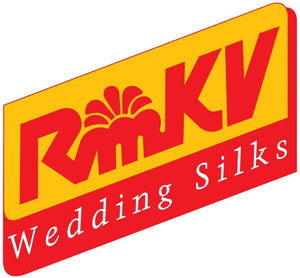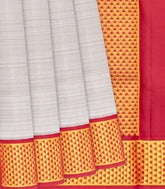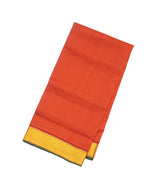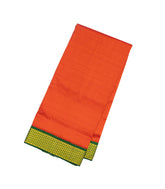-
Blue Handloom 9 Yards Kanchipuram Silk Saree With Zari Checks-Blue
This handwoven 9 yards kanchipuram silk saree is filled with zari checks in blue body along with contrast aquamarine border and palluMRP:- ₹26,488
- ₹26,488
- Unit price
- per
-
Grey Handloom 9 Yards Kanchipuram Korvai Silk Saree With Crimson Border-Grey
This handwoven 9 yards kanchipuram korvai silk saree is filled with plain grey body along with contrast crimson border and palluMRP:- ₹27,384
- ₹27,384
- Unit price
- per
-
Hot Pink Handloom 9 Yards Silk Saree With Zari Border-Hot Pink
This handwoven 9 yards silk saree with plain hot pink body along with diamond motifs in zari border and palluMRP:- ₹12,096
- ₹12,096
- Unit price
- per
-
Light Peach Handloom 9 Yards Korvai Silk Saree With Contrast Border-Light Peach
This handwoven 9 yards korvai silk saree with plain light peach body along with araimaadam motifs in contrast purple border and palluMRP:- ₹18,673
- ₹18,673
- Unit price
- per
-
Mango Yellow Handloom 9 Yards Kanchipuram Korvai Silk Saree With Purple Border-Mango Yellow
This handwoven 9 yards kanchipuram korvai silk saree is filled with plain mango yellow body along with contrast purple border and palluMRP:- ₹32,256
- ₹32,256
- Unit price
- per
-
Red Handloom 9 Yards Silk Saree With Muthu Border-Red
This handwoven 9 yards silk saree with plain red body along with 12 Muthu border and palluMRP:- ₹11,424
- ₹11,424
- Unit price
- per
-
Red Handloom Kanchipuram Nine Yards Silk Saree With Checks-Red
Red Handloom Kanchipuram Nine Yards Silk Saree With Checks-RedMRP:- ₹17,100
- ₹17,100
- Unit price
- per
-
Crimson Handloom Kanchipuram 9 Yards Silk Saree With Annam Chakaram Buttas
This handwoven kanchipuram silk saree is filled with annam chakaram buttas in crimson body along with triangle motifs in zari border and palluMRP:- ₹23,856
- ₹23,856
- Unit price
- per
-
Crimson Handloom Kanchipuram 9 Yards Silk Saree With Annam Buttas
This handwoven kanchipuram silk saree is filled with annam chakaram buttas in crimson body along with floral motifs in zari border and palluMRP:- ₹25,704
- ₹25,704
- Unit price
- per
-
Crimson Handloom Kanchipuram 9 Yards Silk Saree With Zari Stripes
This handwoven kanchipuram 9 yards silk saree is filled with zari stripes in crimson body along with half diamond motifs in zari border and palluMRP:- ₹25,872
- ₹25,872
- Unit price
- per
-
Red Handloom Kanchipuram 9 Yards Payadi Silk Saree With Zari Border
This handwoven kanchipuram 9 yards payadi silk saree is filled with checks in red body along with solid zari border and palluMRP:- ₹25,200
- ₹25,200
- Unit price
- per
-
Dark Green Handloom Kanchipuram 9 Yards Silk Saree With Zari Checks
This handwoven kanchipuram 9 yards silk saree is filled with zari checks in dark green body along with half diamond motifs in zari border and palluMRP:- ₹26,488
- ₹26,488
- Unit price
- per
-
White Handloom Kanchipuram Korvai 9 Yards Silk Saree With Ganga Jamuna Border
This handwoven kanchipuram korvai 9 yards silk saree is filled with plain white body along with diamond motifs in contrast ganga jamuna border and palluMRP:- ₹29,400
- ₹29,400
- Unit price
- per
-
Red Handloom Kanchipuram Korvai 9 Yards Silk Saree With Green Border
This handwoven kanchipuram korvai 9 yards silk saree is filled with plain red body along with half diamond motifs in contrast green border and palluMRP:- ₹28,392
- ₹28,392
- Unit price
- per
-
Yellow Handloom Kanchipuram Korvai 9 Yards Silk Saree With Checks
This handwoven kanchipuram korvai 9 yards silk saree is filled with checks in yellow body along with mango motifs in contrast navy blue border and palluMRP:- ₹29,064
- ₹29,064
- Unit price
- per
Subscribe To Our Newsletter
Receive early access to new arrivals, sales, exclusive content, events and much more!

































